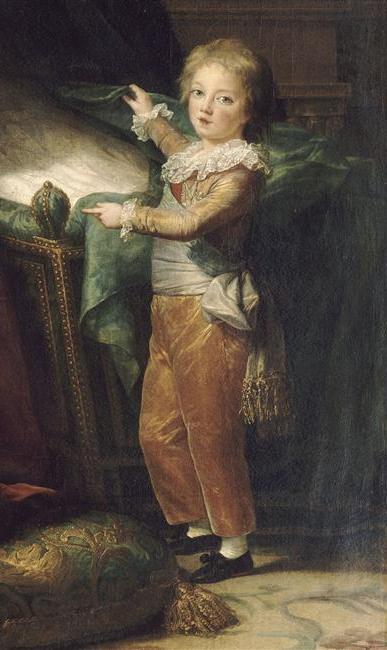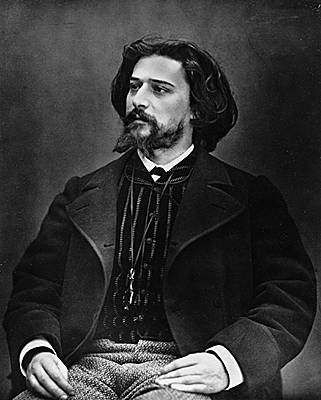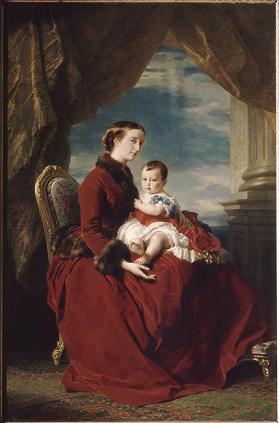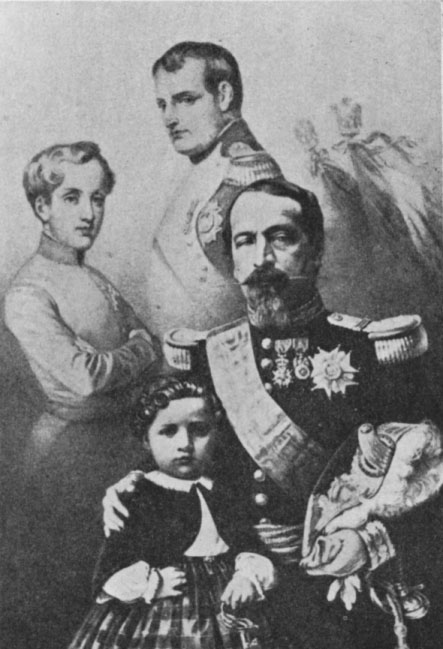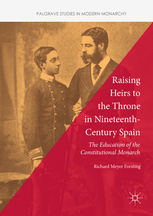A Child of France
Heidi Mehrkens
When the French novelist Alphonse Daudet published his ballad in prose The Dauphin’s Death in a Parisian literary journal in 1866, he certainly left many a reader misty-eyed. The poem’s main character is a little prince, a sick and suffering boy who is finding it hard to accept that his exalted position as heir to the throne of France will not in the least protect him from dying. Daudet describes how the whole court is waiting with bated breath for the worst to happen and even the church bells remain anxiously silent. The king, desperate and full of grief, has locked himself into a chamber, ‘all alone, at the end of the castle… Majesties do not appreciate if one sees them cry’. The queen however never leaves the dauphin’s bedside and holds her son’s hand ‘with tears streaming down her beautiful face, sobbing loudly in front of everyone, just like a draper’s wife would have done’.[1]
The little prince remains utterly unaffected by the whole commotion. Sweet-natured and in all innocence he tries his best to console his mother by explaining to her that nothing could happen to him since the dauphin lives forever and therefore cannot die. Well, just to be on the safe side the little prince then calls for forty guards to surround his bed – in case the reaper were to try to sneak in and snatch him anyway.
Yet still everyone around him is crying, even the soldiers, brave old troopers, are too touched to speak. The adults’ strange behaviour causes the boy’s confidence to dwindle and the prince politely enquires if his little friend Beppo would possibly be so kind as to die in his place (and of course be paid generously for this favour). When the dauphin is gently reminded by the family priest that he could not even take his beautiful and richly embroidered clothes to heaven, to mark out his rank amongst the other angels, he finally bursts into tears: ‘But then’, the prince exclaims, ‘being dauphin really means nothing!’ (‘D’être Dauphin, ce n’est rien du tout!’)
Even though Alphonse Daudet’s little prince remains nameless, the poem clearly refers to the ancien régime monarchy. The title Dauphin de France had been given to the heirs-apparent of the ruling Houses of Valois and Bourbon since the fourteenth century; the last prince to be styled dauphin was Louis Antoine d’Artois, Duc d’Angoulême, eldest son of King Charles X and heir to the throne 1824-30. An illustrated version of Daudet’s poem, which became famous as a children’s book, identified the dying prince with the eldest son of King Louis XVI and Queen Marie-Antoinette: Dauphin Louis-Joseph, who succumbed to tuberculosis in 1789, at the tender age of seven.
Whether poor little Louis-Joseph was in fact the child Daudet had in mind when writing the piece in 1866 cannot be said with certainty. The author came from a legitimist family in the south of France. Yet for several years he had earned a living in Paris as secretary to Charles Duc de Morny, a half-brother of Emperor Napoleon III. Daudet’s biographer Sachs suggests that the successful novelist and playwright worked in an ‘ideological vacuum’ and never aspired to be a political writer. Being close to the Bonaparte Court, while part of a family that kept fond memories of the Bourbons, Daudet certainly never turned into a critic of the institution monarchy as such.
The poem was written and published fourteen years after the establishment of the Second Empire and at first sight it seems strangely out of place, evoking strong reminiscences of a long gone age of absolute monarchs whose right to rule had been thought to stem directly from the will of God. The healing royal touch, which was supposed to be passed on down the royal lineage, remained a widely-held belief way into the nineteenth century, but the last monarch to perform the elaborate ritual to heal the King’s Evil was Charles X in 1825.
But was Daudet’s poem not as much about the constitutional future of the French monarchy as about its absolutist past? Emperor Napoléon III and Empress Eugénie had only one child, a son: Prince Imperial Napoléon Eugène Louis Bonaparte; and here a connection between the poem and dynastic reality might well be assumed. Born in March 1856, Prince Louis had grown to be a ten year old little rascal and (quite unlike Daudet’s dauphin on his sickbed) he was constantly reassured that it meant a lot to be Bonaparte’s heir and the future Napoleon IV – the destiny of a young and ambitious royal dynasty.
As soon as the empire had been re-established in December 1852, the former Prince-President Louis Napoléon Bonaparte went to great lengths to secure the future of the new royal regime. He was well aware that his empire was a construct without proper dynastic tradition and hence built on shaky foundations: Born from a veritable coup d’état, the regime rested mainly on widespread reverence for the still glorious name Bonaparte. When he came to the throne, Napoleon III was known as an unmarried adventurer and notorious womanizer; thus establishing a dynasty was of utmost importance to the emperor.
The modifications made to the constitution of 1852 regulated questions of hereditary succession and confirmed the authority of a Bonaparte dynastic house law. Due to the lack of his own family tree Napoleon started off by patronizing his cousins who were entitled to succeed him to the throne. The altered constitution now provided regulations for an adoption in case the emperor should remain without offspring, adding much to the chagrin of his cousin and next in line Prince Jérôme Napoléon ‘Plon-Plon’ Bonaparte (1822-91), who might have preferred the emperor to remain the ever careless and unmarried ladies’ man with no legitimate children at all.
Indeed securing a suitable bride to realize his dream of a new, thriving dynasty turned out to be a challenging task for Napoléon III. The royal houses of Europe refused to marry one of their princesses to a parvenu and his self-declared democratic empire, both the product of the political and social earthquake that was the 1848 revolution. No less a man than Victor Hugo spread the word of Napoleon Le Petit (as opposed to his immortal uncle Napoleon Le Grand) and like Hugo and his liberal friends many dynasties considered the emperor a criminal and a filou and certainly not equal to one of the established Houses. Hence Napoléon III had nothing to gain from a personal alliance with the European royal circle – it was made utterly clear that he did not belong to them.
He eventually married the Countess Eugénie de Montijo (1826-1920), ‘a young Spanish lady, of good family and great personal attractions’, as the London Times stated on 21 January 1853, a week before the ceremony took place. The engagement met with opposition even in the French imperial family because Eugénie’s rank was considered too low for her to become empress. The Times commented in the same article that the marriage ‘will not have the effect of raising its [the imperial Court’s] dignity in the estimation of foreign States or of society at large. (…) The marriage of the Emperor increases the probability that those hereditary and dynastic claims will be persisted which have not been acknowledged by the rest of Europe.’
When, three years later, Eugénie gave birth to a healthy son the couple was overjoyed. Prince Louis was welcomed into the world with a hundred and one gun salute and styled Child of France, just like a royal prince from the House of Bourbon in the direct line of succession would have been. Why this recourse to a tradition from the ancien régime which, incidentally, outraged France’s legitimist groups?
In an address to the Senate, responding to the warm congratulations on the occasion of the birth of his son and heir, Napoléon explained: ‘I purposely make use of this expression. In fact, the Emperor Napoleon, my uncle, who had applied to the new system created by the revolution all that was great and elevated in the old régime, resumed that old denomination of ‘Enfants de France’. And in truth, gentlemen, when an heir is born destined to perpetuate a national system, that child is not only the offspring of a family, but he is truly, also, the son of the whole country, and the name indicates his duties. If this was true under the old monarchy, which more exclusively represented the privileged classes, with how much more reason ought it not to be to-day, when the Sovereign is the elect of the nation, the first citizen of the country, and the representative of the interests of all?’ (London Times, 20 March 1856)
This rather bold bridging of a historical gap between two very different monarchical systems was again accompanied by modifications to the constitution: On 17 July 1856, when the little prince was four months old, an impressive total of 25 articles regulating in great detail a possible regency for the empire were decreed by the senate. They even included the oath of allegiance sworn to the minor on the throne in case his father were to die before Louis’s coming of age at eighteen. This precautionary measure was a remarkable break with the constitution of the July monarchy which had not provided regulations for a regency at all – a fact that backfired when the heir to the throne Ferdinand Philippe Duc d’Orléans suddenly died in 1842 and a regency law had to be arranged in great haste.
Prince Louis Bonaparte was raised as heir-apparent to the imperial throne, and to a certain degree his education also recurred to earlier monarchical systems: The strong focus on military training from a very tender age was meant to endear the prince to the army, traditionally strong supporters of the Bonaparte regime. And unlike the sons of King Louis-Philippe I, Loulou (as was his pet name) was educated at home and not sent to a public school. Napoléon wanted to spare the boy the humiliation of open criticism expressed by opponents of the regime. Opposition was growing against the emperor in the late 1860s, especially within the middle classes, and sending the prince to school on a daily basis, so the imperial couple decided, would have exposed him to insults or actual dangers. In order to make up for the solitary education and to create the illusion of competition with a peer group, the prince, from 1867, followed the same course of study as was taught at the renowned Lycée Bonaparte. From home the prince wrote a weekly composition with the seventh form of this school and learned the names of the best pupils without ever studying with them directly.
Nevertheless the prince was frequently seen in public. Louis accompanied his father and fulfilled constitutional duties from a very young age: He was, for example, present at the annual openings of parliament and styled president of the Paris Exhibition by the emperor in 1867, at the age of eleven. His royal duties inevitably brought the boy into contact with the different political groups and parties, and the emperor was not always able to avoid getting his son caught up in the crossfire of political opinion.
Ever since the 1740s (and until today) the best high school students within the French education system in France and abroad receive a prize in the Amphitheatre Richelieu at the Sorbonne, in the celebrated and highly renowned competition of the concours général. In the summer of 1868 Napoléon III granted his son the honour to distribute the annual awards. Yet apparently no responsible person seems to have taken the pains to scrutinize the list of prize-winners: One of the awards was given to the son of the deceased republican parliamentarian Louis-Eugène Cavaignac. The father had refused to swear an oath of allegiance to the emperor and been sent to jail for his oppositional political stance; the widow and son now refused to accept his prize from the hands of Napoleon’s heir. What is more, this act of disobedience was met with a prolonged, rather insolent applause by the audience. The prince, utterly humiliated, cried in the carriage on his way home. As Louis’s tutor Augustin Filon recalled in his memoirs: ‘When we got back to Fontainebleau, the Emperor and Empress had already heard of the incident. The Prince was never again exposed to possible adventures of this kind’ (Filon, 43). Prosper Merimée, a friend of the family, stated rather dryly that in his position Louis ought to learn sooner rather than later to confront the opposition.
There were more dangers imminent to a young child and heir than just differing political opinions. In March 1866, six months before Daudet’s poem was published, the prince suffered from an attack of measles and had to stay in quarantine for several weeks. The empress did not leave her son’s bedside. The indisposition of the young royal was anxiously reported in the national and international press, expressing the concern of the imperial parents and the whole Court of France. In the same year two abscesses developed in the prince’s hip and had to be removed by surgery in March 1867. The operation was a success, but Louis recovered only gradually. For two months the prince’s illness was discussed in the press until it was announced at the end of May 1867 that he was about to resume his official duties.
To conclude, Daudet’s poem was written at a time when the monarchical idea was really in need of some support. Napoléon III had a difficult standing in the mid-1860s, when the unpopular handling of French foreign affairs in Mexico and the disastrous effect of Austria’s defeat in the war against Prussia had revived the republican opposition in France. Right from the beginning Louis, in his function as heir to the throne, played an important part in rallying public support for the dynasty, and his well-being was considered a matter of national importance.
The fictitious dauphin on his deathbed and the imperial prince shared the same place within the family; they were not only heirs, but beloved sons of caring parents. The strong emotions described by Daudet might have helped the reader to evoke not only a nostalgic image of the past, but to feel with the current royal family: The Bonapartes were often seen in public and represented as a happy family, seemingly sharing the same joys and suffering the same losses as their subjects, and their dignity and piety were meant to set an example. This apolitical image of royalty was especially meant to appeal to the aspiring middle classes – like the readers of the literary journal Daudet addressed with his poetry.
What is more, Napoléon III himself carefully knitted political connections with the nation’s royal past, by styling his son Child of France and making use of ancient Bourbon traditions. One reason to have his son educated at home was to distinguish his regime from the July Monarchy. He also presented his son publically on occasions linked to the ancien régime, like the venerable award ceremony of the concours général. Destined to become the future of the Bonaparte dynasty, little Prince Louis was at the same time educated to develop a sense of the royal past – a connection Daudet might have touched upon in his poetical work that popularized emotional bonds and parental love within the royal family. Thirteen years later the author actually came back to the topic of an approachable, humanized monarchy, when he published his novel Kings in Exile about a dethroned royal family in republican Paris. Again, it was nothing but a sad reminiscence: By 1879 the star of the Bonaparte dynasty was burnt up and its heir Prince Louis, who never succeeded to the throne, buried together with the Second Empire.
Suggested Further Reading
- Ellen Barlee (1880), Life of the Prince Imperial of France, London
- Alphonse Daudet (1902), Thirty years of Paris and of my literary life, translated by Laura Ensor, London, J.M. Dent & Co.
- Alphonse Daudet (1879), Les Rois en Exil (English version on archive.org: https://archive.org/details/kingsinexile02daudgoog)
- Augustin Filon (1913), Memoirs of the Prince Imperial (1856-1879), London
- Jean-Claude Lachnitt (1997), Le Prince Impérial ‘Napoléon IV’, Paris, Perrin
- Murray Sachs (1965), The Career of Alphonse Daudet. A Critical Study, Cambridge, MA
[1] ‘Et le roi ? Où est monseigneur le roi ?… Le roi s’est enfermé tout seul dans une chambre, au bout du château… Les Majestés n’aiment pas qu’on les voie pleurer… Pour la reine, c’est autre chose… Assise au chevet du petit Dauphin, elle a son beau visage baigné de larmes, et sanglote bien haut devant tous, comme ferait une drapière.’ Alphonse Daudet (1866), La Mort du Dauphin, in: L’Evénement, 13 October, reprint in: Lettres de mon moulin (1869).


